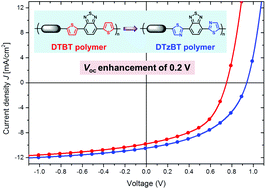High open circuit voltage polymer solar cells enabled by employing thiazoles in semiconducting polymers†
Abstract
We investigate the effect of introducing thiazole π-spacers in wide bandgap semiconducting copolymers based on benzothiadiazole with either benzodithiophene or indacenodithiophene. Thiazole-containing polymers show similar optical bandgaps but drastically downshifted frontier orbital levels compared to the corresponding thiophene derivatives as a result of the more electronegative imine nitrogen. Consequently, they provide an enhanced open-circuit voltage (Voc) of about 0.2 V in bulk heterojunction polymer solar cells. Notably, the Voc approaches 0.95 V for polymers with an optical bandgap below 1.75 eV. Despite the favourable energetics, the performance of the thiazole-containing polymers in solar cells is currently restricted by the relatively low molecular weight, which results in a sub-optimal bulk heterojunction morphology.


 Please wait while we load your content...
Please wait while we load your content...